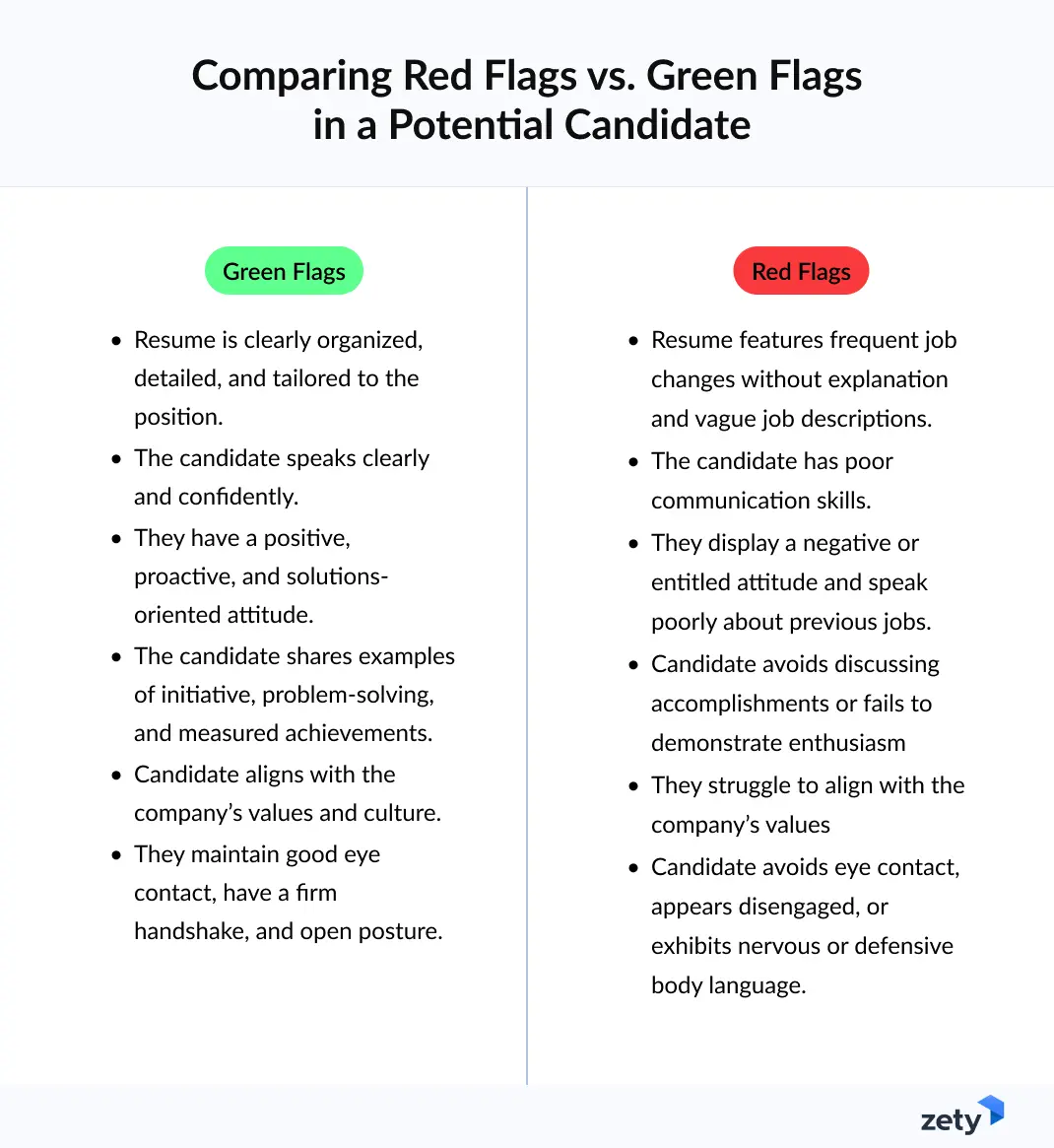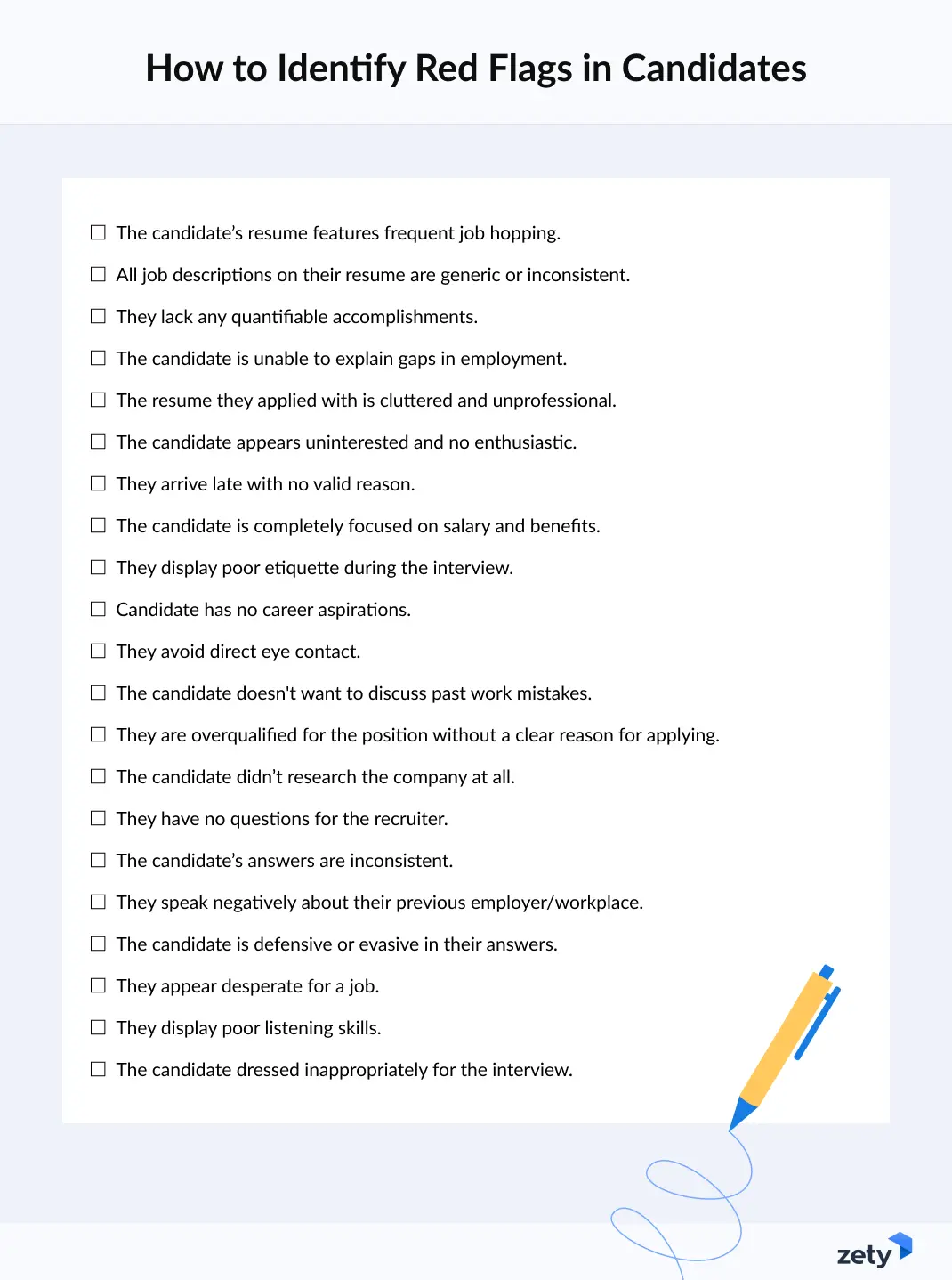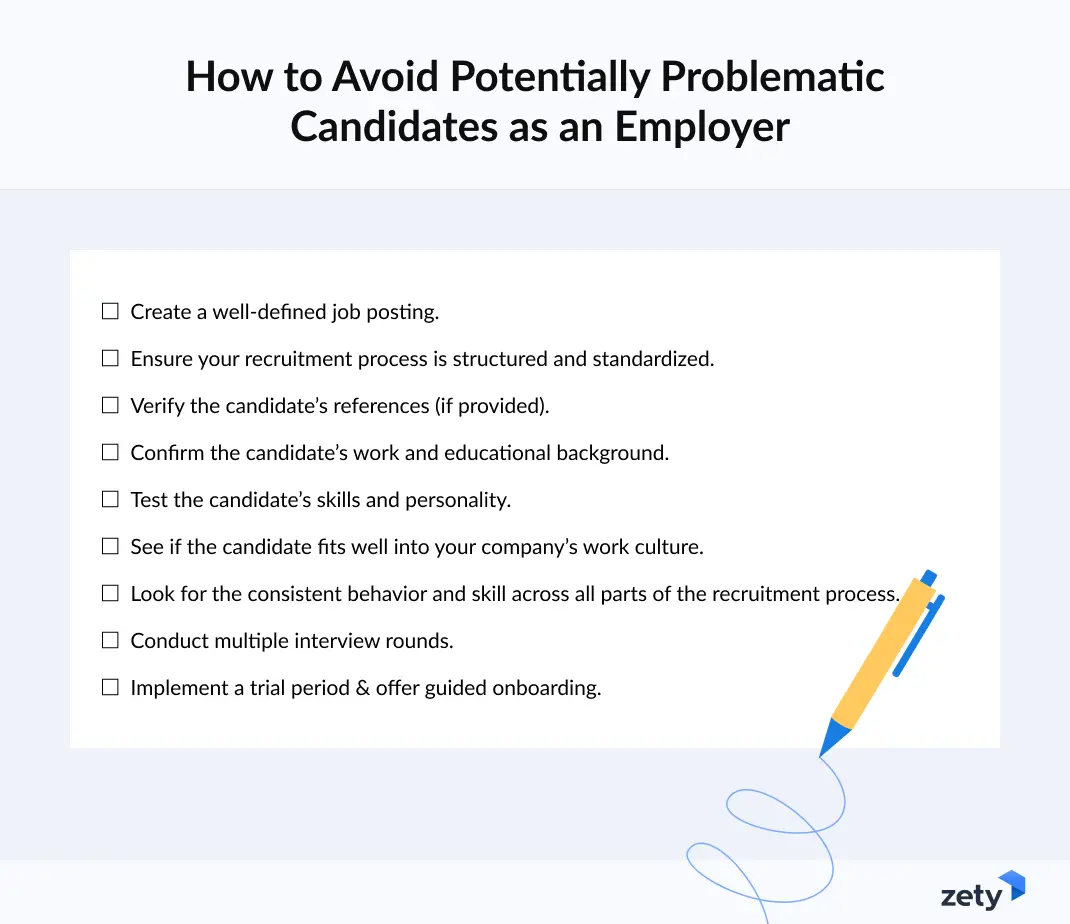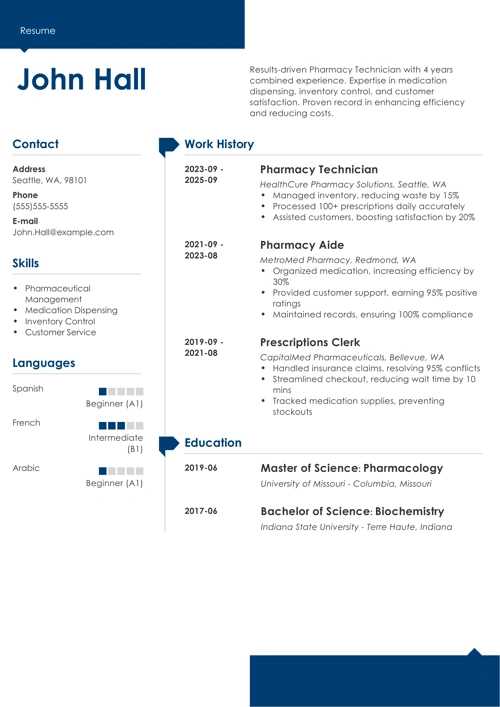Problematic hires can lead to decreased productivity, lower morale, and even increased turnover, costing your company time and resources. So, how do you ensure you bring the best people on board? And if you’re a candidate, how do you know what gives employers the ick? Let me walk you through the common candidate red flags to watch for. I will also share practical tips on avoiding potential pitfalls, so you don’t accidentally hire an employee who’s a walking red flag.
What Are Employee Red Flags?
Employee red flags are warning signs that pop up during the hiring process, indicating that a candidate might not be the best fit for your company. These red flags can help you determine whether a potential employee will be reliable and professional—or if it’s better to look elsewhere.
For example, if a candidate’s resume shows frequent job changes without a clear reason or is vague about their work experience, this can be a sign that they may not be committed or honest about their qualifications. Similarly, if they don’t ask any questions during the interview or show up late, it could indicate a lack of interest or professionalism. Other concerning signs include poor communication skills, a negative attitude, or references that don’t align with their claimed achievements.
Essentially, candidate red flags are your gut-check moments. They make you pause and consider if this candidate is truly what your company needs. It’s important to trust your instincts but also back them up with thorough screening and questioning. After all, you want to build a team that’s cohesive, motivated, and aligned with your organization’s goals. If something feels off, it’s okay to keep searching until you find the right candidate!
But if you’re not sure what to look for, your hiring process might lack the insights needed to avoid potential pitfalls. To help you, here are some common red flags to watch for when evaluating potential hires:

Resume Red Flags
Although employers mostly look for red flags during job interviews, some aspects of resumes could trigger alarm bells. Some of the most common ones are:
1. Frequent Job Hopping
A resume filled with short-term positions can indicate a lack of commitment or an inability to stay in one place for long. While job changes can be common, a pattern without a clear explanation may suggest a candidate is unreliable or has trouble adjusting to new environments.
2. Vague or Inconsistent Job Descriptions
If a candidate’s job descriptions are generic or inconsistent with their claimed job titles, it can be a sign they’re exaggerating their experience or trying to cover up a lack of relevant skills. Be wary if the resume lacks specific achievements or clear responsibilities.
3. Lack of Quantifiable Achievements
Candidates who don’t include specific achievements or metrics might not be as effective in their roles as they claim. Look for applicants who can back up their experience with concrete data, such as “increased sales by 20%” or “reduced customer complaints by 50%.”
4. Unexplained Gaps in Employment
Gaps in employment aren’t necessarily a deal-breaker, but if they aren’t explained in the cover letter or during the interview, it could be a red flag. Ask the candidate to explain these gaps, as they could indicate personal issues, a lack of opportunities, or even a lack of motivation.
5. Stained or Cluttered Resume
Handing over a stained or cluttered resume during an interview can be a major red flag for employers. It suggests a lack of attention to detail, poor organizational skills, and a disregard for presentation standards. A resume that is wrinkled, smudged, or filled with excessive and irrelevant information can give the impression that the candidate is careless or unprofessional.
Job Interview Red Flags
Many red flags could be triggered during a job interview. Of course, setting one or two off might not mean the end of an applicant’s chances, but recruiters are careful. After all, the cost of a bad hire is estimated to be 30% of the employee's first-year earnings. As an employer or recruiter, you should keep an eye out for these red flags in candidates:
1. Lack of Enthusiasm
Candidates who seem disengaged, provide short or uninterested responses, or fail to show curiosity about the role may not be genuinely excited about joining your organization. This lack of enthusiasm can be a warning sign that they won’t be motivated to go above and beyond if hired. Enthusiastic candidates usually display a positive attitude, ask insightful questions, and express genuine interest in contributing to the company’s goals.
2. Arriving Late Without a Valid Reason
Punctuality reflects a candidate’s respect for the interviewer’s time and overall professionalism. If someone arrives late to an interview and cannot provide a valid reason, it indicates poor time management and planning skills. This can be a serious red flag for roles that require strict adherence to schedules, like administrative or customer-facing positions.
3. Overemphasis on Salary and Benefits
While it’s natural for candidates to be curious about compensation, those who focus excessively on salary and benefits without exploring the job role, team dynamics, or company culture may be more interested in the paycheck than in contributing to the organization. This could lead to lower job satisfaction and higher turnover. Ideal candidates will balance questions about compensation with inquiries about job expectations, team collaboration, and career growth opportunities.
4. Unprofessional Behavior
Behaviors such as interrupting the interviewer, being overly casual, or displaying poor etiquette during the interview process can be strong indicators of how the candidate might behave in the workplace. Such actions may suggest a lack of respect for company culture and norms. Candidates should demonstrate professionalism through their communication, attentiveness, and mannerisms, reflecting their ability to fit into a structured work environment.
5. Lack of Clear Career Goals
Candidates who cannot articulate their career aspirations or seem unsure about their professional path might be applying for the position out of convenience rather than genuine interest. This can lead to disengagement and lack of commitment. In contrast, candidates with clear career goals are usually more motivated, driven, and likely to pursue opportunities that align with their ambitions, contributing more meaningfully to the organization.
6. Avoiding Eye Contact
While avoiding eye contact can be a sign of shyness or cultural differences, it may also indicate discomfort, lack of confidence, or dishonesty. Employers need to assess this in conjunction with the candidate's overall behavior and communication style. Confident candidates typically maintain appropriate eye contact, which conveys honesty, self-assurance, and engagement in the conversation.
7. Unwillingness to Discuss Failures or Weaknesses
Candidates who are reluctant to acknowledge past mistakes or areas for improvement may lack self-awareness or the ability to learn from experiences. This can be problematic in roles that require continuous learning and adaptability. In contrast, candidates who openly discuss their shortcomings and the steps they’ve taken to address them demonstrate humility, a growth mindset, and resilience, which are valuable traits in any employee.
8. Overqualification Without a Clear Explanation
While hiring an overqualified candidate may seem like a good deal, it can sometimes result in challenges, such as boredom or a quick exit when better opportunities arise. Candidates who cannot provide a compelling reason for applying to a lower-level position may not be fully invested in the role. However, if they can explain their interest in contributing their skills to a different industry, work-life balance, or other motivations, they could still be a great fit.
9. Lack of Preparation
If a candidate hasn’t taken the time to research your company, it suggests a lack of genuine interest and initiative. Look out for vague or generic responses when asked about your organization, its values, or why they want the role. This can indicate that the candidate has applied to multiple positions without tailoring their application to your specific company.
10. No Questions for the Interviewer
Candidates who don’t ask any questions during an interview might not be seriously considering the position or may not have a clear understanding of what they’re looking for in a job. Asking questions is a key way for candidates to gauge if the role and company are the right fit for them, and it shows their proactive interest in the opportunity. On the other hand, thoughtful questions about the team dynamics, company goals, or growth opportunities indicate that the candidate is genuinely engaged and curious about how they can contribute to and grow within the organization.
11. Inconsistency in Answers
If a candidate’s responses vary throughout the interview or don’t align with what’s on their resume, it could be a red flag for potential dishonesty or poor communication skills. This inconsistency can manifest as changing details about past job responsibilities, dates of employment, or explanations for job changes. It’s essential to probe further when inconsistencies arise to determine whether the candidate is simply nervous, or if there’s a more serious issue at play.
12. Negative Attitude Toward Previous Employers
Speaking negatively about previous employers or colleagues can be a sign of a lack of professionalism and poor interpersonal skills. It may also suggest that the candidate struggles with conflict resolution and could bring a negative attitude into your workplace. This red flag could indicate potential challenges in team collaboration or a tendency to blame others for problems.
13. Evasive or Defensive Responses
Candidates who become defensive or evasive when asked about their experiences, reasons for leaving previous jobs, or gaps in their employment history may be hiding something or uncomfortable with transparency. This defensiveness can make it difficult to have open and honest communication in the workplace, which is crucial for building trust and effective collaboration.
14. Too Eager to Accept Any Role
Candidates who express willingness to accept any role, regardless of their qualifications or career goals, may be more focused on securing a job than finding the right job. This can lead to low job satisfaction and high turnover if they later realize the role doesn’t align with their skills or interests. Look for candidates who have a clear understanding of what they’re looking for and how this specific role fits into their career path, demonstrating a thoughtful approach to their job search.
15. Poor Listening Skills
Candidates who frequently interrupt, ask questions that have already been answered, or fail to respond to what’s being asked can be a red flag for poor listening skills. This can indicate a lack of attention to detail and an inability to engage fully in conversations, which are critical skills for effective communication and collaboration in any role. Poor listeners may struggle to follow instructions, miss important details, or fail to build rapport with colleagues and clients, leading to potential misunderstandings and errors in the workplace.
Look for candidates who actively listen, respond thoughtfully, and engage with what’s being discussed, as these are signs of strong communication skills and a collaborative mindset.
16. Inappropriate Dress Code
Candidates who arrive at an interview dressed inappropriately may lack an understanding of workplace expectations or professional standards. This could mean showing up in overly casual attire for a corporate environment, dressing too formally for a laid-back setting, or wearing clothes that are not well-kept. Such choices can suggest a lack of preparation, respect, or awareness of the company culture.

How to Avoid Potentially Problematic Candidates
So, how should you, as an employer, approach recruitment to proactively avoid problematic candidates? Here are some key steps to help you avoid hiring mistakes and find the best fit for your organization:
1. Craft Clear Job Descriptions
A well-defined job description is your first line of defense. Clearly outline the required skills, experience, and qualifications. Make sure to include specific responsibilities and performance expectations. This helps attract candidates who align with your needs and deters those who are not a good fit.
2. Implement a Structured Interview Process
A standardized interview process ensures all candidates are evaluated fairly and consistently. Use a set list of questions for each interview, focusing on both technical skills and cultural fit. Behavioral questions can be particularly effective in assessing how candidates handle real-world scenarios and challenges.
3. Conduct Thorough Reference Checks
Always verify references provided by the candidate. Ask detailed questions about their past performance, reliability, and behavior in the workplace. If possible, reach out to former supervisors or colleagues not listed as references to get a more comprehensive view of the candidate.
4. Verify Credentials and Background
Take the time to verify the candidate’s education, certifications, and work history. Background checks can also help ensure there are no undisclosed issues that could impact their performance or pose a risk to your organization.
5. Utilize Pre-Employment Assessments
Skills tests and personality assessments can provide valuable insights into a candidate's capabilities and work style. These tools can help you identify potential discrepancies between a candidate’s claimed skills and their actual abilities, ensuring that you’re hiring someone who truly fits the role.
6. Check for Cultural Fit
Beyond technical qualifications, it’s important to assess whether a candidate aligns with your company’s values and culture. Ask questions about their preferred work environment, their attitude toward teamwork, and how they handle feedback. A candidate who fits well with your company culture is more likely to succeed and stay long-term.
7. Look for Consistency Across Different Touchpoints
Evaluate the candidate’s communication throughout the entire hiring process. Are they consistent in their behavior, from their resume and cover letter to their interview and follow-up emails? Inconsistencies in professionalism or attitude could be a red flag.
8. Engage in Multiple Interview Rounds
Consider conducting multiple rounds of interviews with different members of your team. This provides diverse perspectives on the candidate’s fit for the role and can help uncover any potential issues that might not surface in a single interview.
9. Use Trial Periods or Assessments
If possible, implement a probationary period or a short-term project as part of the hiring process. This allows you to evaluate the candidate’s performance in a real-world setting before making a long-term commitment.

Summary
Hiring the right candidate is crucial for your company’s success. Keep an eye out for employee red flags during the recruitment process to avoid hiring someone who might not be the best fit. Trust your instincts, but also rely on a thorough screening process to make the best decision for your team. After all, a solid team is built on trust, collaboration, and shared goals—don’t compromise on these values.
And as a job seeker, remember to look inside yourself, and identify which of the candidate red flags you exhibit. Then, work on yourself to eliminate them. Self-improvement goes a long way both in your private and professional life.
About Zety’s Editorial Process
This article has been reviewed by our editorial team to make sure it follows Zety's editorial guidelines. We’re committed to sharing our expertise and giving you trustworthy career advice tailored to your needs. High-quality content is what brings over 40 million readers to our site every year. But we don't stop there. Our team conducts original research to understand the job market better, and we pride ourselves on being quoted by top universities and prime media outlets from around the world.

